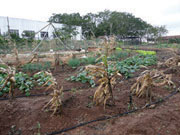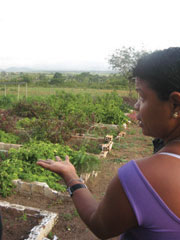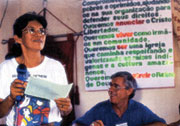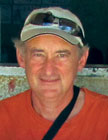Relating lovingly to the land
The Landless Movement in Brazil – the people’s struggle for land and an alternative way of living
By Danny Gillis
January/February 2011
Return to Table of Contents
Print Article
In the 1960s Scarboro missioners arrived in the Amazon to find a great injustice being perpetrated on peasant farmers. Many subsistence farming families were living near the rivers on small plots of land their ancestors had cleared. Though they had tilled and worked this land for two or three generations, very few possessed the deed to their land. A deplorable registra-tion system used by the local Land Title and Registration Office, as well as the corrupt officials who worked there, allowed greedy estate owners to exploit the situation. A few well-placed bribes could make it possible for tax receipts and other official documentation, even land titles, to disappear and for peasant families to be put off their land.
The MST’s success lies in its ability to organize and educate. Members have not only managed to obtain land and therefore food security for their families, but also continue to develop a sustainable socio-economic model that offers an alternative to today’s dominant model.
One of the Scarboro priests who championed the cause of the peasant farmers was Fr. George Marskell. Fr. Marskell saw a geopolitical link in the land theft that was occurring in the hinterland of the Amazon. He could see that Brazil’s military government was intent on legitimizing the extensive land holdings of large landowners. He observed that the appropriation of Amazonia by cattle-raisers, agro-industrialists and mining enterprises was a process of corruption that would lead to the internationalization of Brazilian territory. And he said, “All this was carried out with the connivance of most of the democratic governments of the developed West.”
When George Marskell was appointed bishop of the prelacy of Itacoatiara in 1978, he carried his concerns to the Brazilian Bishops Conference. He took a special interest in the newly established Land Pastoral Commission (CPT) set up by the bishops in 1975 as a response to the atrocious situation of the landless in Brazil. Even now, after years of struggle, 1.6% of the country’s landowners control roughly half (47%) of the land on which crops can be grown. Since its inception, the CPT has played a decisive role in promoting the Brazilian farmers’ access to land, water, and other rights. It was instrumental in founding what has become the largest and most important social movement in Latin America—the Movement of Landless Rural Workers, known as the MST.

 While visiting Normandy Farm and the Paolo Friere School of Formation, we were shown an organic garden called a mandala, which students learn about at the school. At the mandala’s centre is a duck pond that supplies water and natural fertilizer to the rest of the garden. Beds of vegetables, herbal plants, and fruit trees encircle the pond.
While visiting Normandy Farm and the Paolo Friere School of Formation, we were shown an organic garden called a mandala, which students learn about at the school. At the mandala’s centre is a duck pond that supplies water and natural fertilizer to the rest of the garden. Beds of vegetables, herbal plants, and fruit trees encircle the pond.
Officially formed in 1985, the MST carries out a program of peaceful occupation of unused land. On these lands they help peasants construct houses, clinics, and schools for children and adults; they establish cooperative farms; they promote indigenous cultures and gender equality, and they promote a healthy and sustainable environment. MST asserts that land occupations on unused land are rooted in the Brazilian Constitution, which says that land must have a “larger social function.” The land occupation strategy used by the MST has won land title for more than 350,000 families living in 2,000 settlements. MST supports another 180,000 encamped families currently awaiting government recognition and title.
The MST’s success lies in its ability to organize and educate. Members have not only managed to obtain land and therefore food security for their families, but also continue to develop a sustainable socio-economic model that offers an alternative to today’s dominant model which puts profits before people.
Development & Peace partners
Both the CPT and the MST are long-time partners of the Canadian Catholic Organization for Development and Peace. Since their earliest days, the two groups have relied on Development and Peace for financial support. However financial support is only one aspect of the partnership. All three organizations are bound together by their membership in a movement that struggles for the same goals while helping each other to further their understanding of the situation of the landless. In fact, all who support the cause to bring about beneficial change for the landless of Brazil are part of this dynamic movement. Certainly Scarboro Missions and the people who support Scarboro and Development and Peace can see themselves as part of this wider movement of justice for the landless.
In August of last year, our group of seven Development and Peace members had the opportunity to visit three communities each at very different stages in confronting the issue of landlessness. One was the Fazenda Jabuticaba (see page 22), supported by the MST. This community, living in makeshift tents and facing regular eviction, is in the most difficult stage of their struggle. Desperately poor, they long for the day when their efforts will be rewarded. A second community (see page 10), supported by the CPT, had just won title to their land after years of incredible oppression. The struggle, the violence perpetrated upon them, and the victory they achieved are very fresh in their minds. They are now on the cusp of building a life of stability and abundance. The third community is a settlement called Assentamento Normandia (Normandy Farm).
 The People’s Assembly, held every two years, brings together the communities throughout the Prelacy of Itacoatiara. Scarboro missionary Bishop George Marskell (seated above) saw his pastoral mission as one of empowering the people, recognizing their dignity as sons and daughters of God. He said, “I hope to see the day when people have enough to eat, just salaries, better working conditions, title to their land; because this is what God wants—fullness of life for all people.”
The People’s Assembly, held every two years, brings together the communities throughout the Prelacy of Itacoatiara. Scarboro missionary Bishop George Marskell (seated above) saw his pastoral mission as one of empowering the people, recognizing their dignity as sons and daughters of God. He said, “I hope to see the day when people have enough to eat, just salaries, better working conditions, title to their land; because this is what God wants—fullness of life for all people.”
Supported by the MST in their 10 year struggle to obtain land title, Normandy Farm is a community of 50 families each living in a solidly built house with a backyard cistern to store their water, with livestock, thriving communal gardens, and a school for their children. The community has access to health care and receives twice-a-week water delivery from the local municipality.
In 1998 the MST set up a model farm and an adult formation school in the community. Named the Paolo Freire School of Formation after one of the movement’s icons, each year the school accepts peasants from various organizations and other MST settlements into a program of leadership formation. The three-year program equips the students with practical skills such as animal husbandry, gardening (such as the mandala see photo), building cisterns, the use of herbal medicines, and so on. It also equips them with leadership skills and an understanding of the ethos of the movement of which they are an integral part. They spend part of each year at the school and the remainder of the year at their farms and communities. At the end of three years, after a graduation ceremony and the going-away gift of a pig, the students are expected to go and serve their community as leaders and builders. Individuals come to see themselves as being at the service of their community and of the movement.
In 1991 Bishop Marskell (known as Dom Jorge by the people of his diocese), travelled to Sweden to accept a prestigious award on behalf of the CPT. That year the Right Livelihood Award, popularly known as the Alternative Nobel Prize, was awarded jointly to the CPT and the MST. The CPT “for their dedicated campaigning for social justice and the observance of human rights for small farmers and the landless in Brazil,” and the MST “for winning land for landless families and helping them to farm it sustainably.”
In his acceptance speech, Dom Jorge said, “we are witnesses to our people’s creativity in the search for alternatives and their wanting to relate lovingly, yes lovingly with the land. Because for them land is not a piece of merchandise but rather a place and a condition of life. We know that by attaining land our people will gain citizenship and the possibility of an alternative way of living in an alternative society.”
Danny Gillis is the Development and Peace regional animator for the Atlantic provinces. He is a former Scarboro lay missioner who spent four years in the Philippines among the Manobo tribal peoples. He and his wife Kathy live in Antigonish, Nova Scotia.
The struggle for land
On the first day of May 1993, 179 families occupied the Normandy Farm on the outskirts of the city of Caruaru. The occupation became a symbol of resistance and of the struggle for land in the state of Pernambuco. The families were evicted from the land four times, each eviction followed by a re-occupation. On April 17, 1996, 14 members of the community began a hunger strike, vowing to starve themselves if the land was not given to the community as their own. The strike received widespread publicity and 11 days later victory was achieved with a promise by the government to provide land for the 179 families, some on Normandy Farm and some in other areas of the state. Today 41 families live at Normandy Farm. The old manor house on top of the highest hill in the area has been transformed into the Paolo Freire Formation Centre, named in homage to the great Pernambucano popular educator
Return to Table of Contents
Print Article
